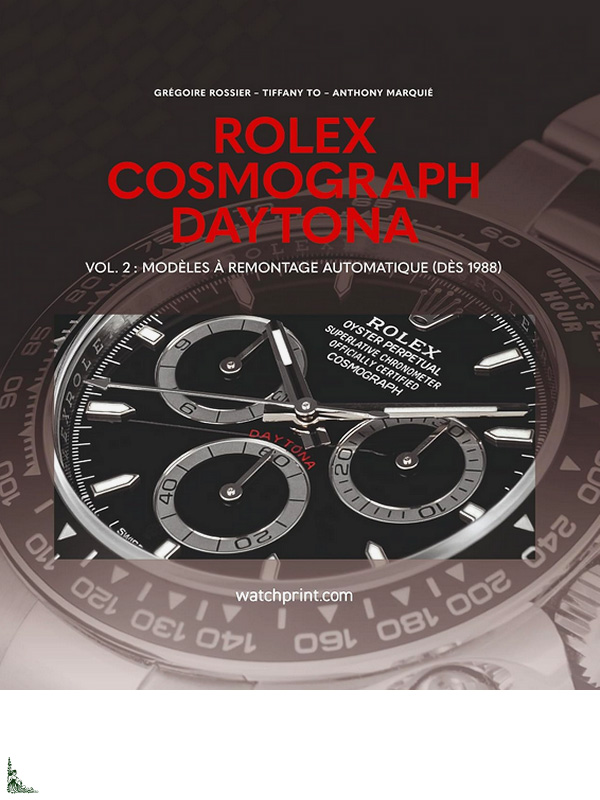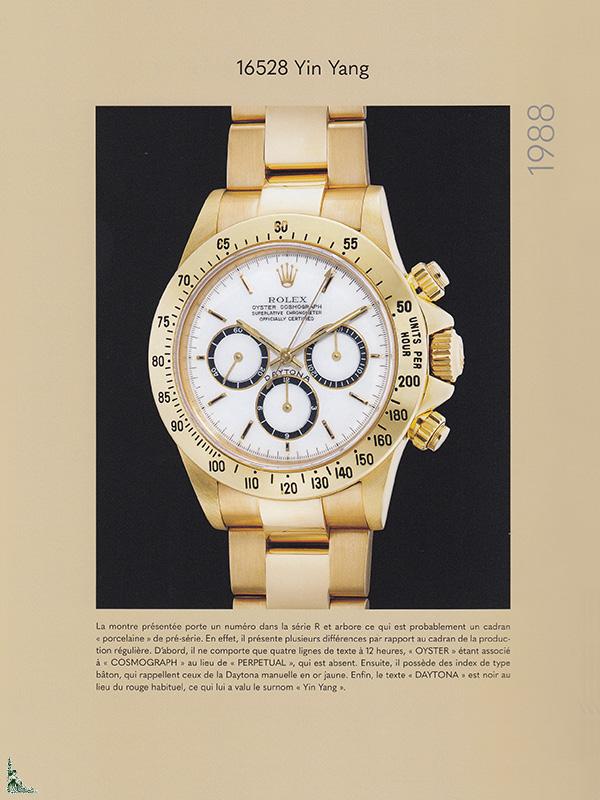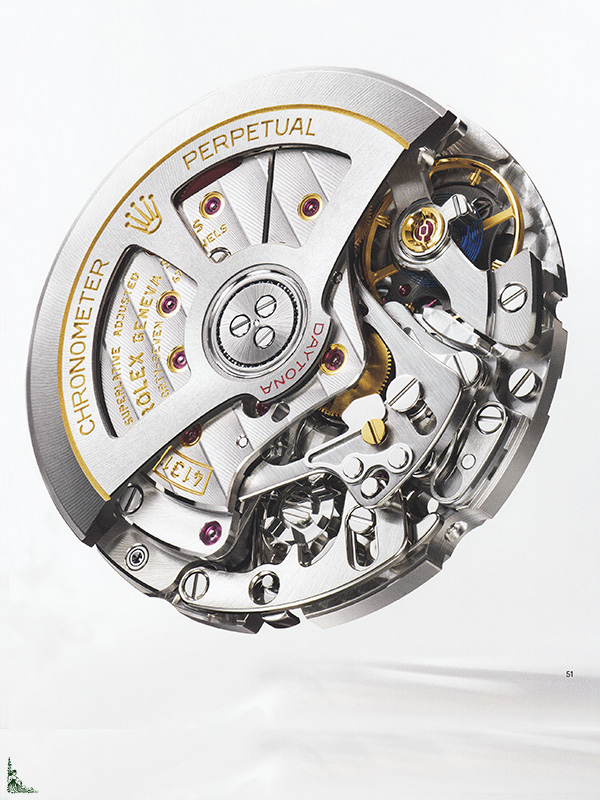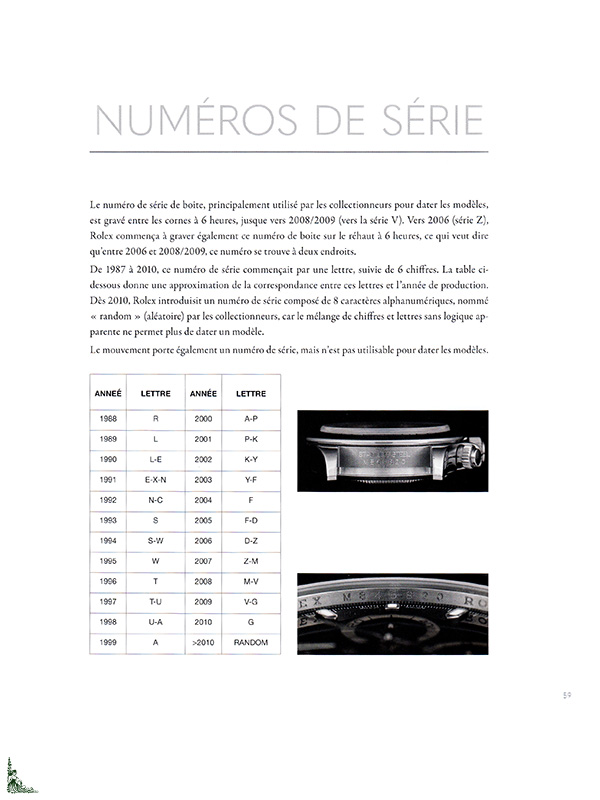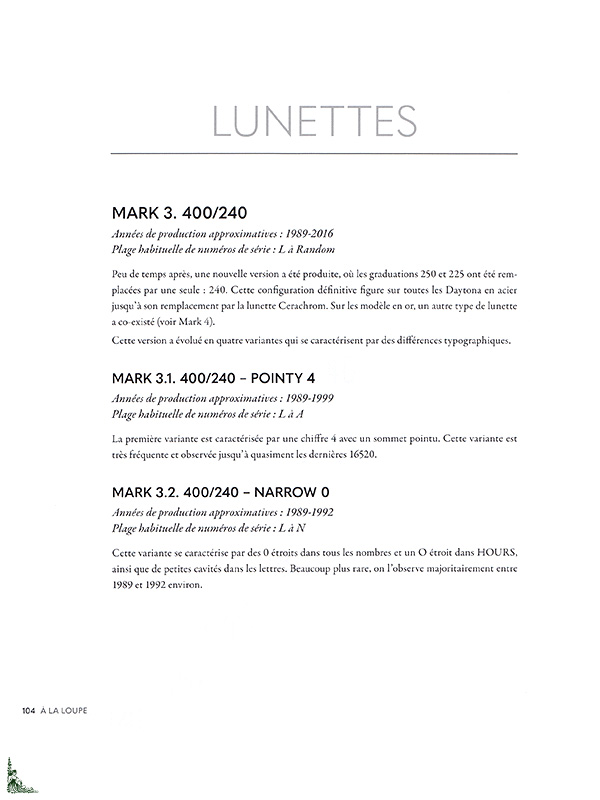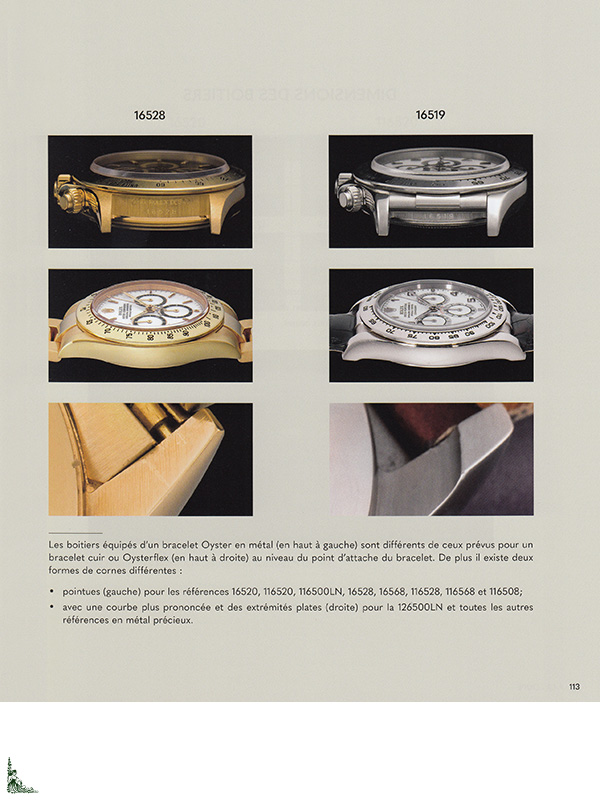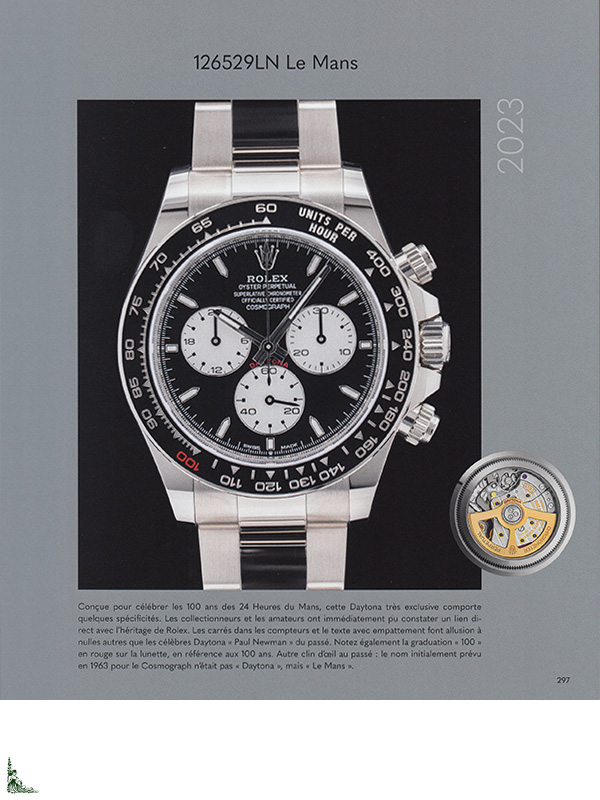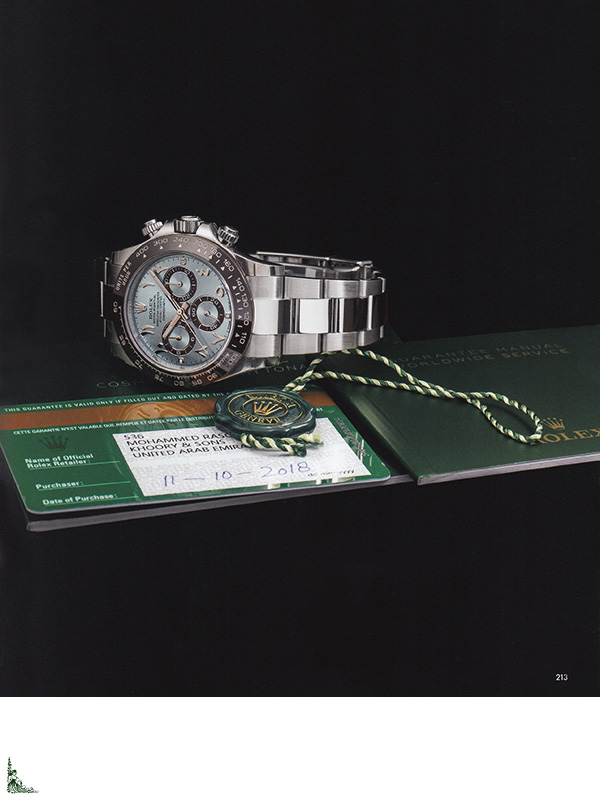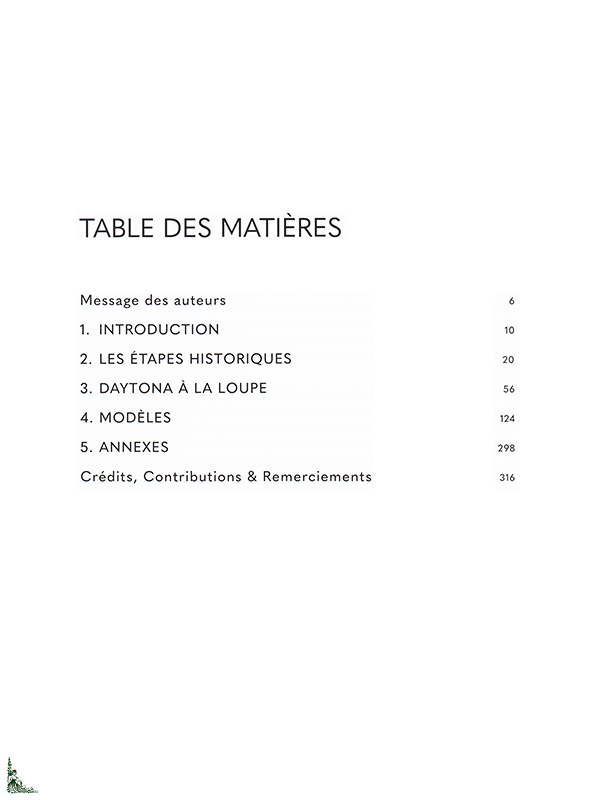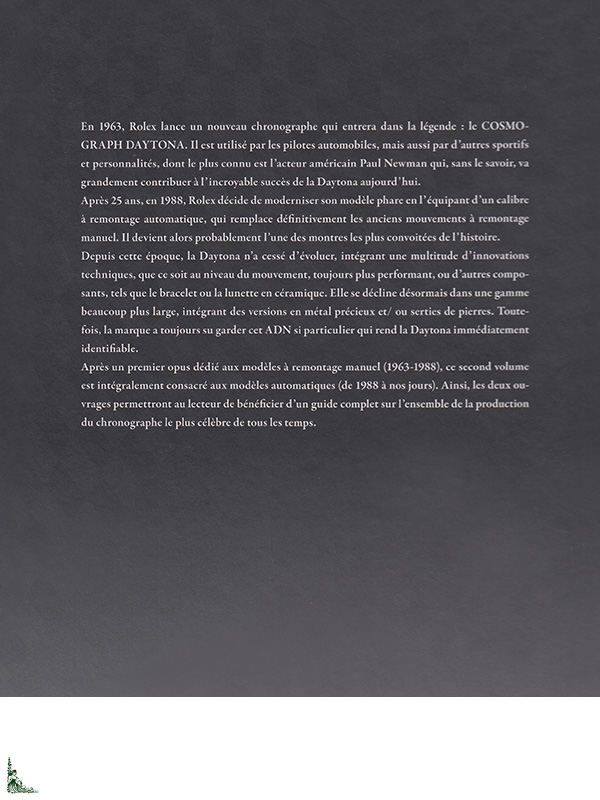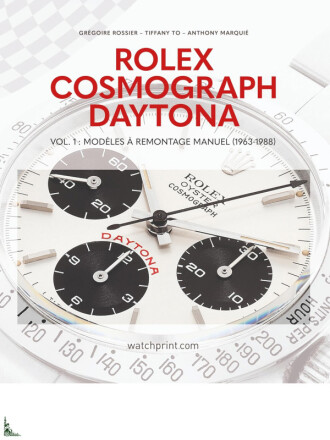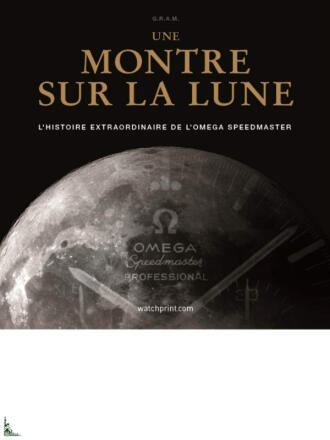Rolex Cosmograph Daytona Vol. 2 : Self-Winding Models (from 1988)
Buchinformationen
| Autoren : | Grégoire Rossier & Anthony Marquié |
| Herausgeber : | Watchprint (2024) |
| Bindung : | Hardcover (320 full color pages) 9-½ inches x 11 inches |
| Sprache : | French |
| ISBN : | 978-2-940506-57-6 |
| EAN : | 9782940506576 |
Beschreibung
Rolex Cosmograph Daytona Vol. 2 : Self-Winding Models (from 1988), by G. Rossier and A. Marquié, Ed. Watchprint, 9-½ inches x 11 inches ( 24 cm x 28 cm ), hardcover book with 320 full color pages
This hardcover book with 320 color pages presents the COSMOGRAPH DAYTONA watch from ROLEX.
COSMOGRAPH DAYTONA... a legendary name among watch enthusiasts, a name that evokes the speed and roar of motor racing, but is also synonymous with prestige and admiration. The origin of this myth is linked to a city in Florida, Daytona Beach, famous for its motorcycle and car races on its eponymous beach. In 1959, the Daytona 500 race began at the Daytona International Speedway and three years later, Rolex became the official timekeeper, marking the beginning of the history of the famous Cosmograph Daytona.
The chronograph complication and the history of Rolex have always been inextricably linked. Rolex's first foray into time measurement began in the 1930s with the Manufacture's very first Oyster chronograph model. In 1963, Rolex launched the Cosmograph Daytona, a sports chronograph that has continued to evolve in keeping with the spirit of the brand, striving to improve existing technology and push the boundaries of technical feasibility.The history and great diversity of this chronograph are such that two (independent) volumes are dedicated to it.
After 25 years, in 1988, Rolex decided to modernize its flagship model by equipping it with a self-winding caliber, which definitively replaced the old manual-winding movements. It then probably became one of the most coveted watches in history. Since then, the Cosmograph Daytona has continued to evolve, incorporating a multitude of technical innovations, whether in terms of the movement, which is ever more efficient, or other components, such as the bracelet or the ceramic bezel.
Il se décline désormais dans une gamme beaucoup plus large, intégrant des versions en métal précieux et/ou serties de pierres. However, the brand has always managed to keep this very special DNA which makes the Daytona immediately identifiable.
After a first opus dedicated to hand-wound models (1963-1988), the authors publish this second volume entirely devoted to automatic models (from 1988 to the present day). Thus, the two books will allow the reader to benefit from a complete guide to the entire production of the most famous chronograph of all time.
Contents:
- Message from the authors
- 1 / Introduction
- 2 / Historical stages
- 3 / Daytona under the microscope
- 4 / Models
- 5 / Annexes
The French texts are written by Grégoire Rossier and Anthony Marquié.
 Description française
Description française
Rolex Cosmograph Daytona Vol. 2 : Modèles à remontage automatique (dès 1988)
Détails du livre
| Auteur : | Grégoire Rossier & Anthony Marquié |
| Éditeur : | Watchprint (2024) |
| Reliure : | Relié (320 pages couleurs) 24 cm x 28 cm ( 9-½ inches x 11 inches ) |
| Langue(s) : | Français |
| ISBN : | 978-2-940506-57-6 |
| EAN : | 9782940506576 |
Description
Rolex Cosmograph Daytona Vol. 2 : Modèles à remontage automatique (dès 1988), de G. Rossier et A. Marquié , Ed. Watchprint, 24 cm x 28 cm, relié avec 320 pages couleurs
Cet ouvrage relié avec 320 pages couleurs présente la célèbre montre COSMOGRAPH DAYTONA de ROLEX.
COSMOGRAPH DAYTONA... un nom légendaire parmi les amateurs de montres , un nom qui évoque la vitesse et le rugissement des courses automobiles, mais qui est aussi synonyme de prestige et d'admiration. L'origine de ce mythe est liée à une ville de Floride, Daytona Beach, célèbre pour ses courses de motos et d'automobiles sur sa plage éponyme. En 1959, la course Daytona 500 voit le jour sur le Daytona International Speedway et trois ans plus tard, Rolex en devient le chronométreur officiel, marquant le début de l'histoire du célèbre Cosmograph Daytona.
La complication chronographe et l'histoire de Rolex ont toujours été inextricablement liées. La première incursion de Rolex dans la mesure du temps commença dès les années 1930 avec le tout premier modèle de chronographe Oyster de la Manufacture. En 1963, Rolex lance le Cosmograph Daytona, un chronographe de sport qui n'a cessé d'évoluer dans le respect de l'esprit de la marque, s'efforçant d'améliorer la technologie existante et de repousser les limites de la faisabilité technique. L'histoire et la grande diversité de ce chronographe sont telles que deux volumes (indépendants) lui sont dédiés.
Après 25 ans, en 1988, Rolex décide de moderniser son modèle phare en l'équipant d'un calibre à remontage automatique, qui remplace définitivement les anciens mouvements à remontage manuel. Il devient alors probablement l'une des montres les plus convoitées de l'histoire. Depuis cette époque, le Cosmograph Daytona n'a cessé d'évoluer, intégrant une multitude d'innovations techniques, que ce soit au niveau du mouvement, toujours plus performant, ou d'autres composants, tels que le bracelet ou la lunette en céramique.
Il se décline désormais dans une gamme beaucoup plus large, intégrant des versions en métal précieux et/ou serties de pierres. Toutefois, la marque a toujours su garder cet ADN si particulier qui rendent la Daytona immédiatement identifiable.
Après un premier opus dédié aux modèles à remontage manuel (1963-1988), les auteurs publient ce second volume intégralement consacré aux modèles automatiques (de 1988 à nos jours). Ainsi, les deux ouvrages permettront au lecteur de bénéficier d'un guide complet sur l'ensemble de la production du chronographe le plus célèbre de tous les temps.
Principaux chapitres de l'ouvrage :
- Message des auteurs
- 1 / Introduction
- 2 / Les étapes historiques
- 3 / Daytona à la loupe
- 4 / Modèles
- 5 / Annexes
Les textes en Français sont de Grégoire Rossier et Anthony Marquié.


